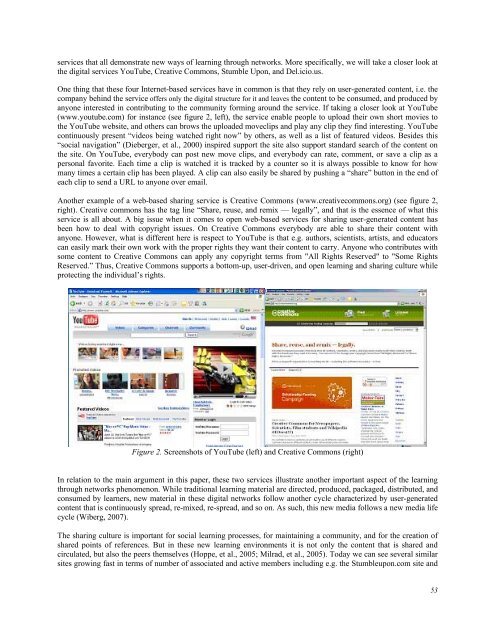October 2007 Volume 10 Number 4 - Educational Technology ...
October 2007 Volume 10 Number 4 - Educational Technology ...
October 2007 Volume 10 Number 4 - Educational Technology ...
Create successful ePaper yourself
Turn your PDF publications into a flip-book with our unique Google optimized e-Paper software.
services that all demonstrate new ways of learning through networks. More specifically, we will take a closer look at<br />
the digital services YouTube, Creative Commons, Stumble Upon, and Del.icio.us.<br />
One thing that these four Internet-based services have in common is that they rely on user-generated content, i.e. the<br />
company behind the service offers only the digital structure for it and leaves the content to be consumed, and produced by<br />
anyone interested in contributing to the community forming around the service. If taking a closer look at YouTube<br />
(www.youtube.com) for instance (see figure 2, left), the service enable people to upload their own short movies to<br />
the YouTube website, and others can brows the uploaded moveclips and play any clip they find interesting. YouTube<br />
continuously present “videos being watched right now” by others, as well as a list of featured videos. Besides this<br />
“social navigation” (Dieberger, et al., 2000) inspired support the site also support standard search of the content on<br />
the site. On YouTube, everybody can post new move clips, and everybody can rate, comment, or save a clip as a<br />
personal favorite. Each time a clip is watched it is tracked by a counter so it is always possible to know for how<br />
many times a certain clip has been played. A clip can also easily be shared by pushing a “share” button in the end of<br />
each clip to send a URL to anyone over email.<br />
Another example of a web-based sharing service is Creative Commons (www.creativecommons.org) (see figure 2,<br />
right). Creative commons has the tag line “Share, reuse, and remix — legally”, and that is the essence of what this<br />
service is all about. A big issue when it comes to open web-based services for sharing user-generated content has<br />
been how to deal with copyright issues. On Creative Commons everybody are able to share their content with<br />
anyone. However, what is different here is respect to YouTube is that e.g. authors, scientists, artists, and educators<br />
can easily mark their own work with the proper rights they want their content to carry. Anyone who contributes with<br />
some content to Creative Commons can apply any copyright terms from "All Rights Reserved" to "Some Rights<br />
Reserved.” Thus, Creative Commons supports a bottom-up, user-driven, and open learning and sharing culture while<br />
protecting the individual’s rights.<br />
Figure 2. Screenshots of YouTube (left) and Creative Commons (right)<br />
In relation to the main argument in this paper, these two services illustrate another important aspect of the learning<br />
through networks phenomenon. While traditional learning material are directed, produced, packaged, distributed, and<br />
consumed by learners, new material in these digital networks follow another cycle characterized by user-generated<br />
content that is continuously spread, re-mixed, re-spread, and so on. As such, this new media follows a new media life<br />
cycle (Wiberg, <strong>2007</strong>).<br />
The sharing culture is important for social learning processes, for maintaining a community, and for the creation of<br />
shared points of references. But in these new learning environments it is not only the content that is shared and<br />
circulated, but also the peers themselves (Hoppe, et al., 2005; Milrad, et al., 2005). Today we can see several similar<br />
sites growing fast in terms of number of associated and active members including e.g. the Stumbleupon.com site and<br />
53

















